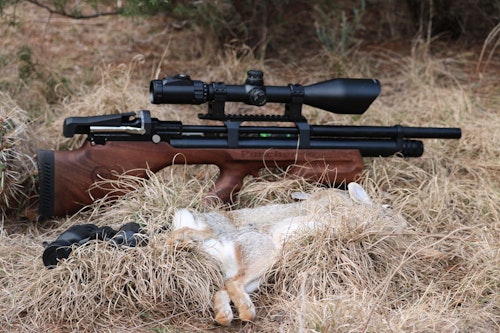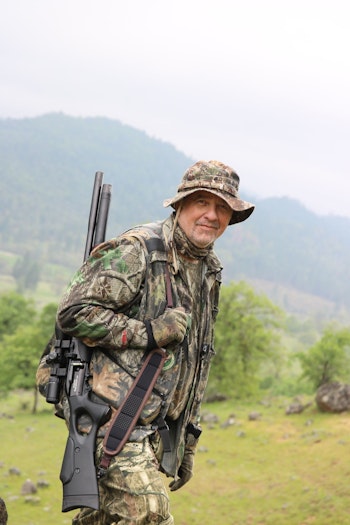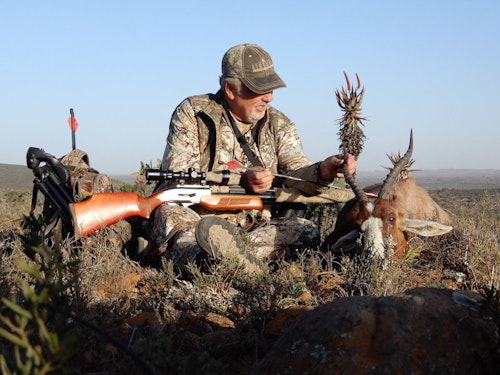There is a long tradition of both hunting and firearm ownership in the United States. However, in much of the rest of the world, civilian ownership of firearms is restricted or prohibited, and there is a limit on huntable species and land on which to hunt. The solution for sportsmen in many of these locales has been the airgun — there are fewer restrictions on ownership, and for the type of small game and pest control shooting available to hunters in much of Europe and Asia, airguns are well suited. These guns tend to be quiet, have a limited carrying range, and produce low energy levels that are still more than adequate for most small game hunting.
But while the airgun market was expanding globally, it did not gain traction in the U.S. until a few years ago. These are not the youth-market airguns we were familiar with from our childhoods, but rather very well crafted, powerful, and accurate adult-sized shooting platforms. Airgun hunting on this side of the pond started to attract interest for a couple reasons. First, airguns are practical where firearms are not, in situations in which noise and excessive carrying range are to be avoided. But also, they provide a challenging hunting experience that combines the close-range hunting experience of bowhunting with more traditional marksmanship skills.
In South Africa, big bore airguns have been used to take all types of large game, up to Cape buffalo.”
As the sport of airgun hunting gained momentum in the U.S., a couple of fundamental differences emerged: we have a variety of small game and pest species to hunt, longer range shooting may be required and we don’t have the power or caliber restrictions placed on airguns in many countries.
There are a couple of domestic companies producing adult air rifles, but most are manufactured in the UK, Sweden, Spain, Germany, Turkey and Korea. In response to the growing U.S. market, these companies started building guns that targeted the North American demographic: more powerful and with a greater selection of calibers. The expanding lineup of calibers extended beyond the traditional .177 and .22 Diablo-style pellet lineup to the .25, .30 and .35 caliber. Additionally, as we started using airguns for larger quarry such as predators and hogs, guns capable of shooting cast lead bullets and arrows became available. The result was that more hunters joined the airgunning ranks, and grassroots movements lobbied states to adopt new airgun hunting regulations. There are now several jurisdictions that allow airguns not only for small game and predators, but also for large game.
Small Game
Small game and varmint hunting opportunities are to be found throughout the country. Virtually every state allows airguns to be used for taking pest species such as ground squirrels and pigeons, but most allow them for small-game hunting as well. A few states also allow turkey, quail, and other game birds to be harvested with airguns.
Besides the effectiveness of the modern airgun to cleanly anchor small game, the fact that they are quieter and safer than firearms mean they can be used to hunt in areas where firearms are either not practical or not permitted. The result is more opportunity to participate, and potential hunters that may have been interested but discouraged by costs or availability of land or game now have an entry into the sport. And many experienced hunters who continue to hunt with their firearms or bows find that they can extend their field time by incorporating airguns into their hunting repertoire.
Varmint/predator hunting is another opportunity for airgunners, and many states allow airguns to be used in place of firearms for raccoon, fox, bobcat and coyotes. While some predator hunters make a move from firearms to airgun hunting exclusively, the majority add an airgun to the lineup for specific applications. The right rifle will allow a coyote to be dispatched at 60 yards, quietly and with little chance of pass-through and reduced risk of collateral damage. This is just the right tool for shooting (where legal) on a golf course or sub-division, around an industrial area, or in an agricultural setting with equipment, people and livestock in proximity.
Small-Game Airguns
Airguns used for small-game hunting primarily employ one of two powerplants: the spring piston rifle using either a mechanical spring or a gas spring to generate power, or the precharged pneumatic (PCP) power plant that uses a charge of compressed air from an external source, typically a high-pressure air tank filled at a dive shop or paintball shop.
Each of these guns has advantages and disadvantages. Spring piston rifles are less expensive and self-contained, requiring no additional charging gear. They are appropriately powered for small game, are readily available, and work efficiently with smaller calibers (.177 and .22). The disadvantage of this power plant is that the guns tend to be larger and heavier, with a more pronounced bi-directional recoil, making them harder to shoot accurately under hunting conditions.
A PCP is a more compact and lightweight rifle. They are virtually recoilless and very accurate. Most are auto-indexing multishot, and they are efficient at driving larger calibers and generating much greater power. On the negative scorecard, PCPs tend to be more expensive, filling accessories (probes, hoses and airtanks) are required, and a place to fill tanks must be located. An advantage of both spring-piston airguns and PCPs is that once you have the requisite equipment, the cost of shooting is lower than even a .22 rimfire, and you can set up a shooting range in the basement, garage or backyard. Nothing makes a hunter a better shot than shooting a lot!
Examples of the types of guns I recommend for small-game hunting, starting with springers, are as follows.
The Gamo Whisper Fusion .22 caliber is a break-barrel rifle that features an integrated sound dampening system that will get you into the squirrel woods for an MSRP of $249.99. This is an entry-level rifle that will provide accuracy, adequate power, and a reasonable cocking effort. Moving to a higher end springer, the Walther LGV .22 is a solid, beautifully crafted German break-barrel air rifle, with the smoothest out-of-the-box shooting characteristic I’ve experienced. It is dead accurate, facilitated by an adjustable match trigger. This rifle can be found selling at the $620 mark.
One of the newer entry-level PCP rifles that is helping break down the price barrier is the Umarex Gauntlet, available in .177. .22, and .25. This rifle is priced under $300, yet feature-rich; it is regulated and multishot, and it features a fully shrouded barrel and a high shot capacity. In the mid-range, the Brocock Compatto is priced at $699.99 and is hard to beat: It’s compact, lightweight, very accurate, powerful and available in .177, .22, and .25. The barrel is a Lothar-Walther mounted on a one-piece breech block with an outstanding two-stage adjustable trigger. Another one of my favorite small-game guns is the FX Impact, probably the most technologically sophisticated field gun available. The rifle comes in .177, .22. .25 and .30 for shooting standard Diabolo pellets. It uses the FX 700mm Smooth Twist X barrel housed in an interchangeable liner system, which allows liners with specific twist rates to be used for shooting bullets rather than pellets.
Big Game
About 20 years ago, a small group of us started using custom big-bore air rifles to hunt predators, hogs and exotics in the handful of states where airguns were a legal method of take. As the sport gained visibility, the number of big-game airgun hunters increased, and in response, more states started revising their regulations. Predators and hogs were initially targeted, but now that several states have instituted airgun-friendly laws, deer, elk, pronghorn, javalina and bear can be legally taken with airguns in several jurisdictions. In South Africa, big-bore airguns have been used to take all types of large game, up to Cape buffalo.
It is important to note when pursuing larger game with a big-bore air rifle that it more closely parallels bowhunting than a conventional rifle hunt. The hunter needs to move in closer and be more selective with the shot. As these guns do not generate a hydrostatic shock, exact placement on the vital organs is the goal. It is this challenge driving the rapid growth in this hunting segment, exactly as it did with bowhunting in the past.
PCPs are the only power plant appropriate for hunting big game, where a larger caliber and greater energy are required. It is important to match the gun to the quarry and conditions, because two rifles using the same projectile can offer vastly different performance. This is because with airguns, the energy is stored in the gun and not the ammunition. The energy is a function of the fill pressure of the rifle, the pressure and volume of air released behind the projectile, and other more nuanced ballistics factors. For this reason, I tend to judge big game guns by power level rather than caliber.
An excellent big-bore rifle for predator hunting that’s also capable of taking larger game at closer range is the Hatsan Hercules Bully in .35. This multi-shot bullpup is available in a range of calibers, though I like the .35 as a primary predator gun that can be used for the occasional big-game hunt. The MSRP on the Bully is $899.99. If you are looking for a traditionally styled rifle that performs the same duties as a primary predator gun, the Air Venturi Seneca Recluse .357 is another solid option. This single-shot rifle is lightweight and ergonomic and has adjustable power settings reaching up to 150 fpe.
With airguns, the energy is stored in the gun and not the ammunition.”
A newer development in big-game guns is the use of arrows, which can reach truly impressive velocities when fired from an air rifle. The concept has been around for a while, but it is arguably the U.S.-based manufacturer Crosman that has driven this market forward with the Benjamin Pioneer Airbow. This bullpup-configured rifle sends a 375-grain air bolt downrange at close to 450 fps, surpassing all but the most powerful crossbows. The Pioneer AirBow is priced at $999.99, which includes gun, optics and nine arrows.
Another U.S.-based manufacturer is making very powerful big-bore airguns available to a broader market: AirForce Airguns with their Texan big-bore lineup. The Texans are single-shot powerhouses, with the .457 doing about 600 fpe out of the box. The Texan comes in a rifle or carbine configuration using Lothar Walther barrels in .257, .308, 357 and 457 calibers. The action is a fast-cocking sidelever. The gun features a very nice trigger and has adjustable power that lets you optimize performance for a specific bullet: the equivalent of handloading for a firearm.
The take-away is that the participation in both small-game and big-game airgun hunting is increasing the demand for airguns and related products, and this in turn is driving the release of more new products to market. Concurrently, more states are revising or adding new regulations every year, further expanding the potential of this market segment.
Airgun Accessories
There are several companies offering optics that target the airgun community: Hawke, MTC, Athlon, Leaper and CenterPoint all offer scopes designed for airgun shooters. These generally have an adjustable AO suited for the closer airgun ranges and Mil dots or aim points to assist in judging the more pronounced airgun trajectories.
Airgun manufacturers such as Crosman, Gamo and Hatsan often carry a proprietary line of pellets, sometimes manufactured in-house and sometimes an OEM from one of the major producers. JSB, H&N, RWS are the largest manufacturers globally, and all offer a range of pellets in different weights, calibers and head configuration.
While many of the airgun distributors carry a range of steel, aluminum and carbon fiber (CF) high-pressure airtanks (HPA), there are also (mostly online) business that manufacture or distribute tanks directly. Companies such as Expert HPA offer tanks, hoses, fittings and compressors.
An ancillary business has developed around tuning, modifying and customizing airguns to optimize performance based on specialty applications, enhanced ergonomics, or enhanced aesthetics. Companies such as Mad Dog Stocks are designing and manufacturing stocks for the AirForce lineup of rifles and carbines, and others, such as Saddle Mountain Gunsmith, have specialized in tuning specific models, in their case the Seneca line of big-bores.
State Regulations
As mentioned, many states have permitted the use of airguns for hunting small game for some time. California has had written regulations on the books for several years; Texas only allowed airguns as a method of take for pest, predators and non-indigenous species, though this has changed in a significant way this year. There are only a couple of States that prohibit airguns for small-game hunting. About half of the states allow coyotes to be taken with airguns, and about a dozen allow feral hogs to be taken. California, Michigan, Florida, Virginia, and Maryland have all approved airguns as a method of take for turkey.
In the last few years, Missouri, Virginia, Kentucky, Tennessee, Alabama, Arkansas, Michigan and a few others allowed airguns to be used for deer hunting, typically in the rifle season. But the changes adopted by Arizona and Texas (this year), were all encompassing and allowed any game species to be taken by airguns (except for elk in AZ). The increasing opportunity along with the expanding airgun offerings on the market is resulting in more hunters traveling to do destination hunts with their airguns.







